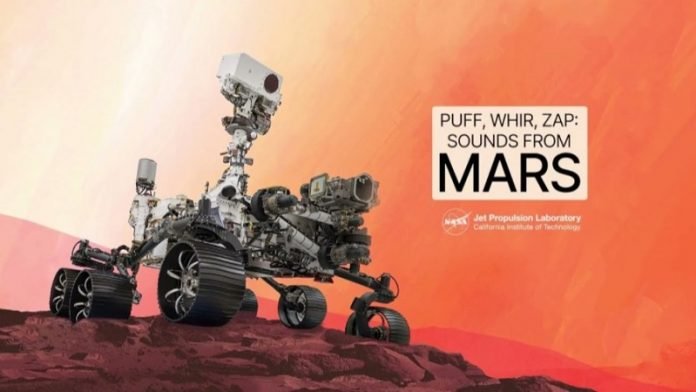
Listen closely to sounds from Mars, recorded by NASA’s Perseverance:
The rover’s mechanical whine and click in a light Martian wind; the whir of rotors on Ingenuity, the Mars helicopter; the crackling strike of a rock-zapping laser.
An international team of scientists has done just that, performing the first analysis of acoustics on the Red Planet.
Their new study reveals how fast sound travels through the extremely thin, mostly carbon dioxide atmosphere, how Mars might sound to human ears, and how scientists can use audio recordings to probe subtle air-pressure changes on another world – and to gauge the health of the rover.
“It’s a new sense of investigation we’ve never used before on Mars,” said Sylvestre Maurice, an astrophysicist at the University of Toulouse in France and lead author of the study.
“I expect many discoveries to come, using the atmosphere as a source of sound and the medium of propagation.”
Most of the sounds in the study, published in the journal Nature, were recorded using the microphone on Perseverance’s SuperCam, mounted on the head of the rover’s mast.
The study also refers to sounds recorded by another microphone mounted on the chassis of the rover.
This second microphone recently recorded the puffs and pings of the rover’s Gaseous Dust Removal Tool, or gDRT, which blows shavings off rocks that the rover has scraped in order to examine.
The result of the recordings: a new understanding of strange characteristics of the Martian atmosphere, where the speed of sound is slower than on Earth – and varies with pitch (or frequency).
On Earth, sounds typically travel at 767 mph (343 meters per second). But on Mars, low-pitched sounds travel at about 537 mph (240 meters per second), while higher-pitched sounds move at 559 mph (250 meters per second).
The variable sound speeds on the Red Planet are an effect of the thin, cold, carbon dioxide atmosphere.
Prior to the mission, scientists expected Mars’ atmosphere would influence sound speed, but the phenomenon had never been observed until these recordings were made.
Another effect of this thin atmosphere: Sounds carry only a short distance, and higher-pitched tones carry hardly at all.
On Earth, sound might drop off after about 213 feet (65 meters); on Mars, it falters at just 26 feet (8 meters), with high-pitched sounds being lost completely at that distance.
The recordings from SuperCam’s microphone also reveal previously unobserved pressure variations produced by turbulence in the Martian atmosphere as its energy changes at tiny scales.
Martian wind gusts at very short timescales also were measured for the first time.
One of the most striking features of the sound recordings, Maurice said, is the silence that seems to prevail on Mars. “At some point, we thought the microphone was broken, it was so quiet,” he added.
That, too, is a consequence of Mars having such a thin atmosphere.
“Mars is very quiet because of low atmospheric pressure,” said Baptiste Chide of Los Alamos National Laboratory in New Mexico, also a coauthor of the study. “But the pressure changes with the seasons on Mars.”
That means, in the Martian autumn months to come, Mars might get noisier – and provide even more insights into its otherworldly air and weather.
“We are entering a high-pressure season,” Chide said. “Maybe the acoustic environment on Mars will be less quiet than it was when we landed.”
Hear what familiar earth sounds would be like on Mars.



